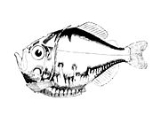
Polyipnus
Encyclopedia
Polyipnus is an ocean
ic ray-finned fish genus
which belongs in the family
Sternoptychidae
. This is the largest genus of the marine hatchetfish
es (Sternoptychinae) and indeed of the entire Sternoptychidae. It is not quite as apomorphic as their relatives; it may be that the genus is actually a paraphyletic assemblage of less advanced Sternoptychinae and would need to be split.
are placed in Polyipnus:
Fossil
s of this genus show that they have existed at least since the Early Oligocene, about 30 million years ago.
Ocean
An ocean is a major body of saline water, and a principal component of the hydrosphere. Approximately 71% of the Earth's surface is covered by ocean, a continuous body of water that is customarily divided into several principal oceans and smaller seas.More than half of this area is over 3,000...
ic ray-finned fish genus
Genus
In biology, a genus is a low-level taxonomic rank used in the biological classification of living and fossil organisms, which is an example of definition by genus and differentia...
which belongs in the family
Family (biology)
In biological classification, family is* a taxonomic rank. Other well-known ranks are life, domain, kingdom, phylum, class, order, genus, and species, with family fitting between order and genus. As for the other well-known ranks, there is the option of an immediately lower rank, indicated by the...
Sternoptychidae
Sternoptychidae
The marine hatchetfishes or deep-sea hatchetfishes as well as the related bottlelights, pearlsides and constellationfishes are small deep-sea bathypelagic ray-finned fish of the stomiiform family Sternoptychidae...
. This is the largest genus of the marine hatchetfish
Marine hatchetfish
Marine hatchetfishes or deep-sea hatchetfishes are small deep-sea mesopelagic ray-finned fish of the stomiiform subfamily Sternoptychinae...
es (Sternoptychinae) and indeed of the entire Sternoptychidae. It is not quite as apomorphic as their relatives; it may be that the genus is actually a paraphyletic assemblage of less advanced Sternoptychinae and would need to be split.
Species
32 living speciesSpecies
In biology, a species is one of the basic units of biological classification and a taxonomic rank. A species is often defined as a group of organisms capable of interbreeding and producing fertile offspring. While in many cases this definition is adequate, more precise or differing measures are...
are placed in Polyipnus:
Fossil
Fossil
Fossils are the preserved remains or traces of animals , plants, and other organisms from the remote past...
s of this genus show that they have existed at least since the Early Oligocene, about 30 million years ago.

